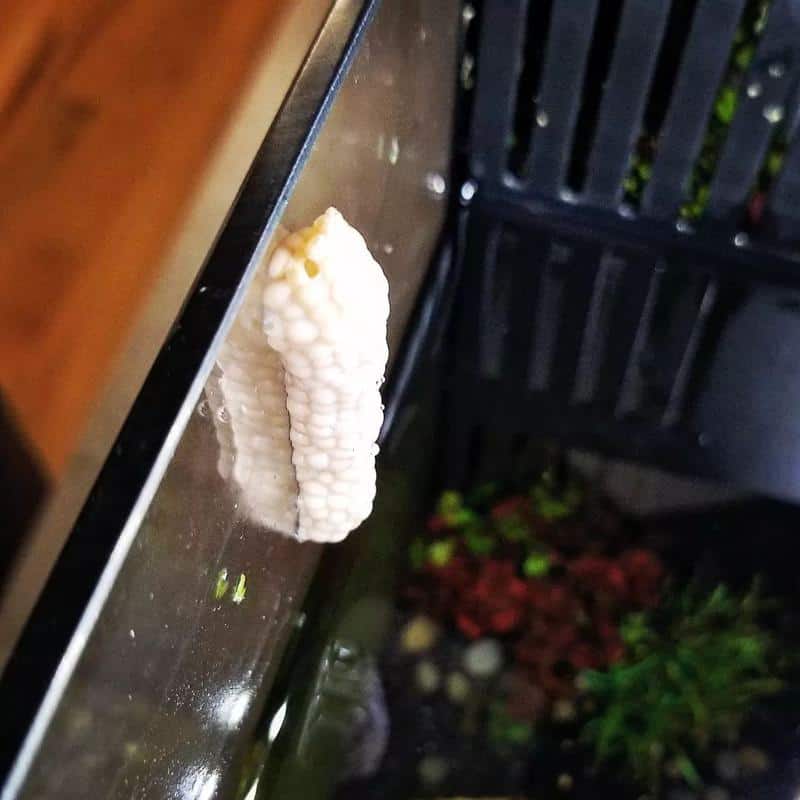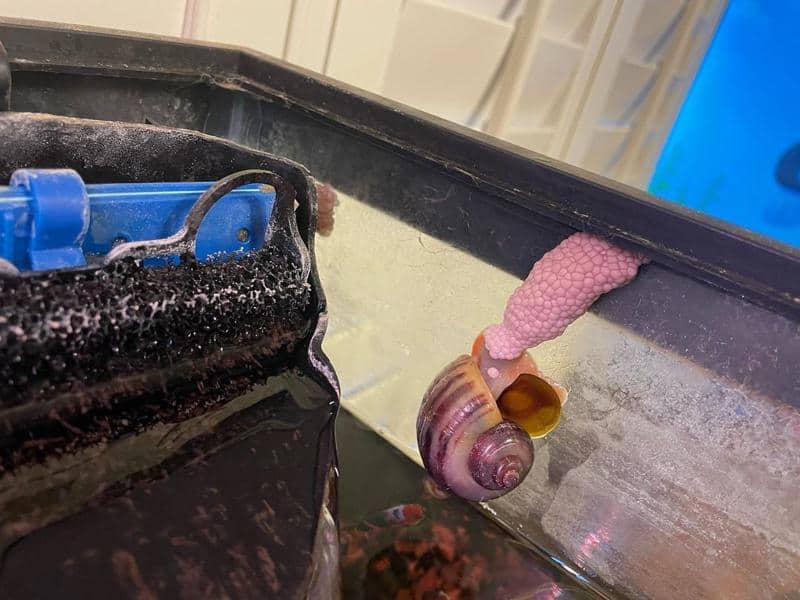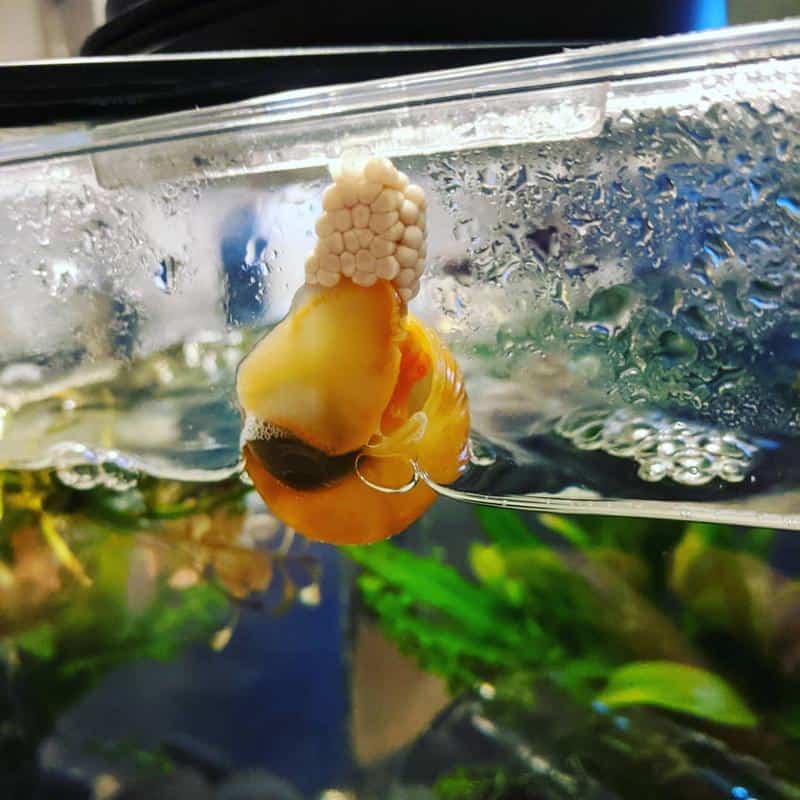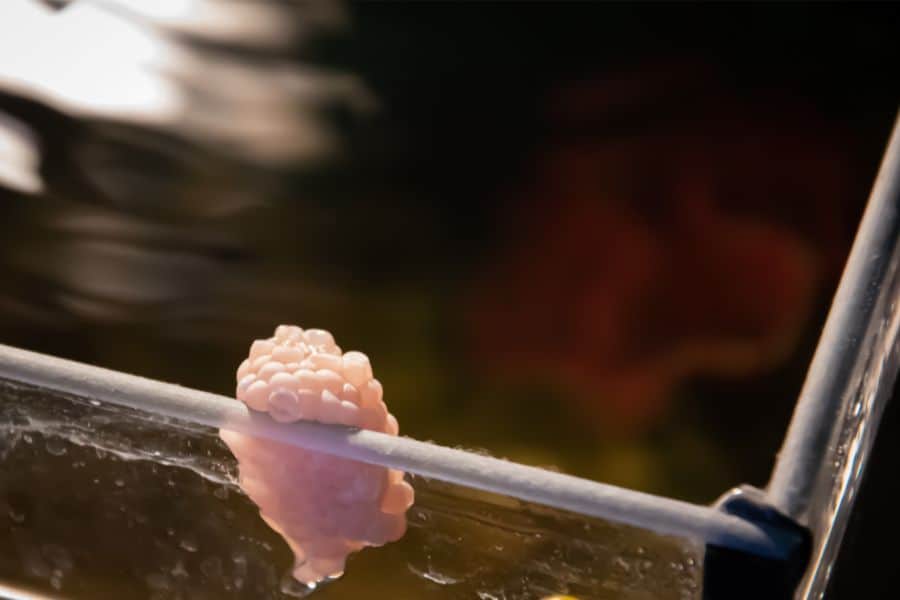Snails are precious creatures to have in any given aquarium since they help keep the ecosystem healthy. However, many aquarists do not anticipate the quick breeding process of snails and the massive number of eggs they can lay.
Snail eggs in fish tanks can also be an eyesore, and some aquarium owners find it hard to decide whether to keep or remove them.
In this article, we will explore the topic of snail eggs in fish tanks and provide insights on whether you should keep or remove them.
What Do Aquarium Snail Eggs Look Like?
What snail eggs look like in an aquarium varies depending on the species of the snail. However, generally speaking, aquarium snail eggs are small, round, often translucent, and in jelly-like sacs.
Most snails typically lay their eggs on hard surfaces within the aquarium, including the décor, live plants, walls, and substrates like rocks and sand. In some cases, you may find eggs above water, on floating plants, or on other objects in the tank.
It is important to note that not all snails lay eggs in the same, easily identifiable spots. Ramshorn snails, for example, tend to lay their eggs on the aquarium glass, while Mystery snails lay eggs above water so as to keep the eggs moist for easy hatching.
The often-translucent eggs make it easy to see the snail embryo developing inside. Different snail species lay different types of eggs, and they may vary in size and color. For instance, Ramshorn snail eggs are tiny, reddish to brown balls, while Apple snail eggs are large, bright pink, and often laid above the waterline.
The color typically changes after fertilization, from whitish/pinkish/blueish translucent colors to darker/browner/blacker colors due to the development of the yolk. A change of color is also a good way to know if the eggs are rotten, that’s if it is accompanied by a rotted smell after a period of about 30 days.
Snail eggs can also appear in different formats, from globules (small round balls) to patches, jelly bubbles, or spot-like. They may also get laid in clusters or singularly.
The size of the eggs can also vary, with some species laying eggs as small as a pinhead while others lay larger eggs that can be seen with the naked eye.
Ramshorn snails are prolific breeders known for laying up to 200 eggs at any given time. Individual eggs are about 3 mm each, and their size grows exponentially thrice in under 72 hours. Assassin snails, on the other hand, lay 1 to 4 eggs at any given breeding season. The eggs look like tiny white dots/spots with a membrane on the outside.
Also, some species of snails may lay their eggs in a gel-like substance, while others lay their eggs directly onto a surface. Regardless, all snail eggs in the aquarium are attached to surfaces with a glue-like substance that holds them together.
Snail Breeding Processes and Egg Growth in An Aquarium

It is important to note that while snail eggs can be interesting to observe in an aquarium, they can also quickly lead to an overpopulation of snails if not managed properly. This is why it is important to know how your snails reproduce.
Most snails reproduce quickly (like Ramshorn snails), but some take months to even lay eggs (like Assassin snails). Some species can breed asexually, making it easier for them to colonize your aquarium, while others do not lay eggs, like the Malaysian trumpet snails which are a live-bearing species (producing through sexual reproduction or parthenogenesis).
Some snails can lay hundreds of eggs at a time, and the eggs usually hatch within a few days, depending on the water temperature.
Once the eggs hatch, the snails can start breeding again in a matter of weeks. Their growth rate depends on various factors such as water temperature, pH levels, and the availability of food.
It is easy to remove the snail eggs once they are attached to surfaces. A thin card like an ID card or razor blade is best for this job as you can scrape the eggs from the surfaces.
However, once the eggs hatch or rupture, then it becomes a bit more complex to remove them. Ruptured eggs will spread inside the tank and make it more challenging to get rid of the snail eggs in your tank. You may also be concerned about the ethical and humane dilemmas of getting rid of a snail’s future generation.
Before you decide what to do, it is also important to know how long it takes for snail eggs to hatch. Aquarium snail eggs on glass or plants will hatch between two to four weeks, five weeks at most. Keeping this timeline in mind will help you prevent the snail eggs from hatching in the aquarium.
With that said, let’s get into the pros and cons of why you should choose to keep or remove the eggs from your tank.
What To Do With Snail Eggs?
What you choose to do with the snail eggs will first boil down to the type of snail you have.
For example, if you have Assassin snails for removing pest snails, then keeping them around is a good idea to prevent infestations. You also won’t want to get rid of Mystery Snails if you bought them for their extremely attractive colors that make your aquarium tank pop.
Therefore, the factors to consider include; the level of infestation in your tank, the purpose of the snails, the rate of reproduction, your maintenance schedule, tank size, and your own taste in aesthetics.
Pros & Cons of Removing Snail Eggs in Your Aquarium

Removing the snail eggs from your tank does not necessarily mean killing the eggs. You may want to remove them and place them in another tank for breeding purposes, to avoid fish preying on them, or to keep the ecosystem of your tank stable.
Pros:
- Prevents snail overpopulation: Removing snail eggs can help prevent snail overpopulation, which can be harmful to the aquatic ecosystem in your aquarium.
- Prevent fish from eating them – Many types of aquarium fish enjoy snacking on snail eggs, and they will waste no time having their stomachs full. If you intend to breed the snails, then removing them from the tank and placing them in another is the best option.
- Reduces water toxicity: Snails produce a lot of waste which leads to spikes in ammonia and nitrates. Removing the eggs can help keep the water parameters stable and prevent healthy fish from dying in a toxic aquarium.
- Aesthetically pleasing: Snail eggs affect the appearance of your tank and may cause it to look less attractive to you. Removing them can make your aquarium more visually appealing.
- Some snails are hard to breed and grow – A hard-to-breed species like the Nerite snail may pose more of a challenge than its worth. Others demand lots of maintenance and varying water parameters which can be hard to meet.
Cons:
- Time-consuming: Removing snail eggs can be a tedious and time-consuming process, especially if the eggs are attached to hard-to-reach surfaces.
- Risk of damaging aquarium surfaces: Scrubbing or scraping off snail eggs can damage aquarium surfaces, such as plants and rocks, which can affect the overall aesthetic appeal of your aquarium.
Pros & Cons of Caring For Snail Eggs in Your Aquarium
Snails are not only good tank cleaners but also great sources of food for you. Did you know that France is the number one consumer of snails, with over 30,000 tons of snails sourced every year? One of the more popular snail dishes you may want to try is snail caviar.
Apart from healthy food sources for humans and fish alike, experienced aquarists also keep snail eggs for commercial purposes.
Pros:
- Natural food source: Snail eggs can serve as a natural food source for other aquarium inhabitants, such as fish and shrimp; the more, the merrier. They are also the source of many delightful seafood platters.
- Commercial purposes – Snail farming is a low-risk business that is often profitable depending on the scale. The most recommended snail farming starter is the Giant African Land Snail.
- Easy to care for Most snail eggs require minimal care, and they can hatch into baby snails that can help maintain a healthy aquatic ecosystem in your aquarium.
- Get rid of algae & uneaten foods – Ramshorn snails and other popular options are great algae eaters; they also feast on leftover fish foods and will devour any plant material that is decaying off the main tree. This helps keep your tank healthy and free of toxic chemical buildup.
- Cost and time saving – Even though snails are cheap and easy to find, having your own breed of snails will lower the costs of purchasing or sourcing new ones from the pet store.
Cons:
- Snail overpopulation & infestations: Caring for snail eggs can lead to overpopulation, which can be detrimental to the aquatic ecosystem in your aquarium.
- Aesthetically displeasing: Caring for snail eggs may not be visually appealing to some aquarium owners.
How to Remove Snail Eggs from Aquarium in 4 Easy Steps

Snails may be helpful for your aquarium, but they can turn into a menace very quickly if they multiply uncontrollably. Here is how to get rid of the snail eggs to prevent overpopulation or any inconveniences:
1. Scrape the Eggs from The Tank
One way to avoid a snail infestation is to remove their eggs that cling to the glass or on live plants. To remove the eggs, you can scrape them off with a thin, flexible card or use a siphon to vacuum them from the aquarium.
Nerite snail eggs, which are white and shaped like small ovals, are harder to remove and may require a razor blade.
2. Let Fish Eat the Eggs – Keep Snail Eaters
Freshwater pufferfish like the tiny pea puffer and loaches like the zebra and crown loaches are good examples of fish that love eating snails as well as their eggs.
Stocking your aquarium with snail-eating fish will ensure you never have to worry about infestations or overpopulation from rampant breeding.
3. Less Food in The Tank
Snails, as well as snail eggs, need a healthy amount of food sources to thrive. If the tank has no other fish you need to feed, you may choose to starve the snail eggs of any nutritious foods that will help them hatch.
Snails also eat algae and dead plant matter, which helps them breed easily. Keeping the algae at bay and pruning the plants is a good preventative measure to ensure you never have to deal with the many snail eggs.
4. Quarantine
It is essential to know how to prevent snail infestations in the aquarium. Another way to do this is to quarantine newly purchased plants in a separate tank before introducing them to your aquarium. Any snail eggs that may have survived on the plants will die off before getting introduced to the main tank.
Another preventive measure is to perform a bleach dip on the new plants before introducing them into your aquarium.
Read More:
FAQs
1. How Did Snail Eggs Get in My Fish Tank?
Snail eggs, similar to snails, are tiny hitchhikers that cling to water plants you introduce into your aquarium. If the plant came from infested waters, then you can be assured the snail eggs will be introduced to your tank if you do not quarantine the plants first.
The eggs may also be introduced into the fish tank in decorations, the substrate, or on the bodies of other aquatic animals, including shrimp and fish.
2. Will Snail Eggs Hatch in My Fish Tank?
Most snail eggs will hatch in the aquarium if left unchecked. However, some eggs, like the Nerite snail eggs, will not hatch since they need specific environmental conditions to hatch.
Conclusion
Locating snail eggs is easy; they are jelly-like sacs of small round translucent spots stacked next to each other and attached to surfaces like glass, walls, décor, plants, ornaments, or above the water.
Apart from identifying them, it is also important to know your snails’ breeding process and the egg-hatching timeline to help decide if you want to keep or remove them.
Snails are important additions to any aquarium since they help maintain the ecosystem’s balance, but their quick breeding process can lead to overpopulation, which you may not want.
Ultimately, your decision to keep or remove the snail eggs will determine what helps you maintain a productive, healthy, and balanced ecosystem in your aquarium.
